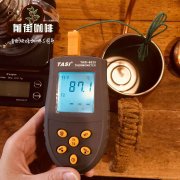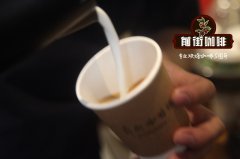Rwanda coffee bean flavor taste aroma description what are the characteristics of Rwanda coffee beans?

Professional coffee knowledge exchange more coffee bean information please follow the coffee workshop (Wechat official account cafe_style)
More than 95% of the coffee varieties grown in Rwanda are Bourbon in Arabica, and a small number are Catuai and Kaddura (Caturra). The planting height is between 1200 and 1800 meters above sea level. The flowering period begins from September to October every year, and the harvest period is from March to July of the following year. In recent years, coffee organizations have introduced new treatments to improve the quality of local production. In Rwanda, almost all raw beans are treated by water washing, and cooperatives and estates share water washing plants to save money.
Rwandan coffee is the most popular African coffee after Kenya and Ethiopia. But unlike the two famous producing countries, it does not have a long history of planting, let alone native varieties everywhere in the wild. This small African country is a fire Phoenix that has been reborn after robbery.
Rwanda (Rwanda), known as the Land of a Thousand Hills, sits above the equator and is surrounded by East African States such as Congo, Uganda, Tanzania and Burundi. Geographically, it has suitable conditions for growing coffee, but since it was introduced by German missionaries in 1904, Rwandan coffee has been poorly handled commercial grade, most of which have been exported to the sovereign country of Belgium. The promotion of boutique coffee production began only after the ravages of war and after the economy got back on track.
The genocide (Genocide), which occurred in 1994, killed more than 1 million people, most of them Tutsi (Tutsi). So far, there are orphans who survived that year, memorial halls that can be seen everywhere, and war criminals who account for 90% of the total number of prisoners in the streets of Rwanda. Since 2001, the Government of Rwanda has established NAEB (National Agriculture Export Development Board), which focuses on promoting coffee exports and earning foreign exchange.
With the support of the government, farmers have changed from rough home treatment to transporting freshly harvested fruit to a nearby water washing station (Coffee Washing Station) for full washing treatment. In a short period of 12 years, the number of washing stations across the country has increased from two to 220. It is now all private, that is, owned by exporters or farmers' cooperatives. Due to the small average area of farmland (less than 200 coffee trees per farm), about 50 to 100 farms are served at each station. NAEB employs 200 botanists and cup surveyors to regularly check quality at washing stations and educate farmers about soil management, organic planting, pruning, disinfestation and picking.
The Karen Gela-West Asia processing plant is located in the green hills in southwestern Rwanda not far from the south bank of Lake Kivu.
It was founded in 2006, although the processing plant is at an altitude of 1800 meters, but the harvest of coffee even reached as high as 2000 Michael degrees.
The coffee cherries selected by the West Asian processing plant are harvested from about 661 small farmers in the area. The yields of these small farmers are small-usually less than one-fourth of a hectare.
They pick ripe coffee cherries by hand, usually in baskets above their heads, and occasionally transport them to the cleaning station by bike or truck.
The West Asia processing Farm is led by Jonathan Zindana, who is an agronomist and one of the most experienced managers in Rwanda.
During the harvest season, the processing plant employs about 100 people, usually from March to July.
Once the coffee cherries are delivered to the West Asian processing plant, they will be carefully sorted by hand to ensure that only red cherries are accepted.
Then, they will choose to scrape the pulp on the same day-mostly at night-and use a mechanical pulper that divides the beans into three grades.
After removing the pulp, the coffee will ferment overnight (about 12 hours), and then use the flotation channel weight to re-screen the coffee and re-classify it (the heaviest is considered the best).
Then soak the coffee beans for another 24 hours, and then select them by hand in the drying process.
This last task is accomplished by experienced women and is the most important quality control.
The selected coffee beans are moved to a high scaffolding-the African bed.
In the sun, they repeatedly open and sort the coffee to ensure it dries evenly and removes any damaged or defective coffee beans.
And store them in a shell until they are ready for export.
From the beginning of the cherry harvest, the coffee will be equipped with a paper card recording the harvest date and grade (A1, A2, etc.).
For example, if a batch of coffee is recorded as "area 106 Universe 04-A1 coffee 39th, this means that it was the first batch to be processed on April 4 and rated A1.
This simple and effective approach is an important tool for controlling quality and ensuring the traceability of batches.
Every season, the treatment plant will donate the excess pulp of the coffee to the surrounding farmers as fertilizer, and establish wastewater treatment using IM technology.
They have recently launched training for these projects to achieve best agricultural practices. This treatment plant is certified by the Rainforest Alliance.
END
Important Notice :
前街咖啡 FrontStreet Coffee has moved to new addredd:
FrontStreet Coffee Address: 315,Donghua East Road,GuangZhou
Tel:020 38364473
- Prev

Ethiopian coffee variety-Hara mocha coffee introduction Hara sun coffee beans how to drink?
Professional coffee knowledge exchange More coffee bean information Please pay attention to coffee workshop (Weixin Official Accounts cafe_style) Ethiopia is the first country where coffee was discovered. Nowadays, there are still many wild coffees collected and used by farmers in primitive forests. Ethiopia is a poor country with constant drought and civil war, but it is still the most important coffee in terms of coffee quality and yield.
- Next

Introduction to the cultivation of coffee varieties in Rwanda characteristic varieties and treatment methods of coffee beans in Rwanda
Professional coffee knowledge exchange more information about coffee beans Please follow the coffee workshop (Wechat official account cafe_style) Bourbon varieties account for more than 90% of Rwanda's production. A small number of farmers grow bourbon variants BM-139 and Jackson. There are more mountains in the south and west, and water washing stations are also more famous. Such as Gitesi, Huye Mountain, and Mibirizi
Related
- Does Rose Summer choose Blue, Green or Red? Detailed explanation of Rose Summer Coffee plots and Classification in Panamanian Jade Manor
- What is the difference between the origin, producing area, processing plant, cooperative and manor of coffee beans?
- How fine does the espresso powder fit? how to grind the espresso?
- Sca coffee roasting degree color card coffee roasting degree 8 roasting color values what do you mean?
- The practice of lattes: how to make lattes at home
- Introduction to Indonesian Fine Coffee beans-- Java Coffee producing area of Indonesian Arabica Coffee
- How much will the flavor of light and medium roasted rose summer be expressed? What baking level is rose summer suitable for?
- Introduction to the characteristics of washing, sun-drying or wet-planing coffee commonly used in Mantenin, Indonesia
- Price characteristics of Arabica Coffee Bean Starbucks introduction to Manning Coffee Bean Taste producing area Variety Manor
- What is the authentic Yega flavor? What are the flavor characteristics of the really excellent Yejasuffi coffee beans?

